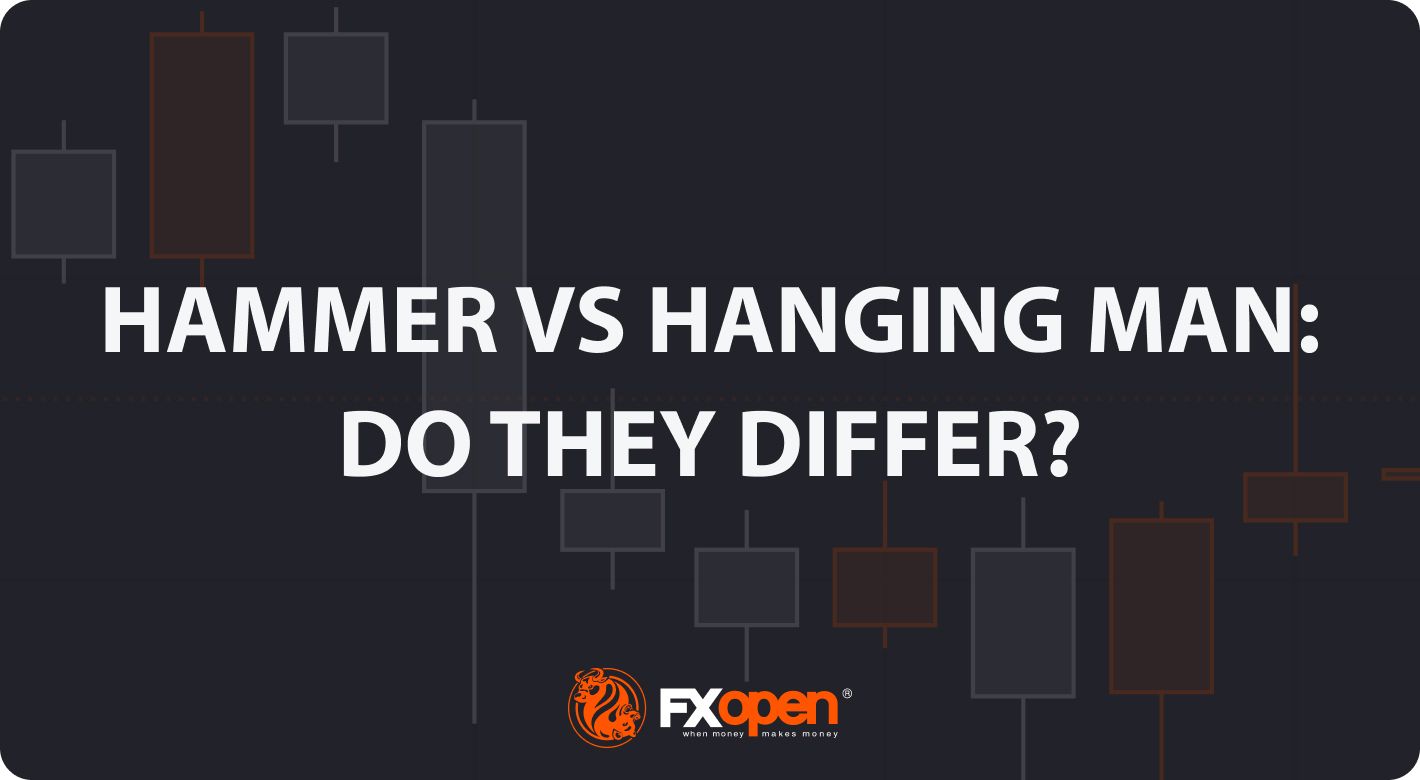FXOpen

Traders in the financial markets often find themselves drawn to the hammer and hanging man candlestick patterns. These setups on price charts provide valuable information for analysis and decision-making. This article will explore the distinctive features of the hammer vs hanging man formations, their importance in trading, and how traders can use the hammer vs hanging man candle on charts.
With the flexibility and accessibility offered by FXOpen, traders can explore various trading tools, including the hammer and the hanging man, leveraging the potential opportunities presented by different financial instruments.
Understanding the Hammer Candlestick
To fully grasp the significance of the hammer, let's delve into its definition and anatomy in detail.
Definition of the Hammer Candlestick Formation
The hammer is a reversal formation that appears at the end of a downtrend. It’s characterised by a single bar with a small body, which can be bullish or bearish and is generally small within the context of the setup, and a long lower shadow. The bar resembles a hammer, hence its name. The upper shadow is usually short or non-existent, representing the highest price equal to the open or close price.
Bullish Signals of the Hammer
The hammer provides a bullish signal, meaning a potential reversal from a bearish to a bullish trend. It usually appears in a strong support zone.
When trading based on the bullish signal of a hammer candlestick, traders usually follow specific rules. These include waiting for confirmation, such as a bullish candlestick or a price close above the high of the hammer candle. Traders may enter a long trade above the high of the hammer candle, set a stop loss below the low of the candle or the nearest swing low to manage risk and add a take profit at the next resistance level.
The above chart shows a hammer formation marked by a green arrow. The trader places a buy trade at the high of the following candle with the stop loss beneath it. The profit target is at the closest resistance level.
Understanding the Hanging Man
Let's explore the definition and anatomy of the hanging man formation.
Definition of the Hanging Man Pattern
The hanging man candlestick pattern is a single bar that typically appears at the top of an uptrend and signals a potential trend reversal from bullish to bearish. The body of the bar is much smaller than the shadow and can be bullish or bearish. The upper shadow is small or non-existent, indicating the highest and open/close prices were almost equal, while the lower shadow is long, meaning that bears tried to pull the price down.
Bearish Signals of the Hanging Man
The hanging man provides a bearish signal, which is a potential trend reversal from a bullish to a bearish trend. It usually occurs at a strong resistance level.
When trading based on the bearish signal of a hanging man, traders may follow certain trading rules. Firstly, they wait for a confirmation, such as a bearish candlestick following the setup or a price close below the low of the hanging man candle. They may enter a short trade below the low of the hanging man candle to confirm bearish sentiment and, anticipating selling pressure, place a take-profit target at the next support level. A stop-loss order is usually set above the formation’s high.
The hanging man setup on the USDCHF chart signals a short trade. The red arrow highlights the hanging man candle. A trader places a short trade below the low of the formation. The position is activated at the fifth candle with a stop loss above the setup and a take-profit target at the next support. Although the common rule states that a stop-loss should be above the hanging man, in the example above, the trade was opened much lower, so following the general rule, the trader would risk more than they could earn.
The FXOpen TickTrader platform allows traders to analyse and trade technical setups such as the one explained above on various assets. Investors can enjoy fast execution and low trading fees in addition to quality customer support at FXOpen.
Final Thoughts
Contrasting hanging man vs hammer candlestick patterns, we can state that although they look similar, it’s vital to distinguish between them as they provide different signals. The hanging man is significant at the top of an uptrend, signalling a bearish reversal, while the hammer may be potent at the bottom of a downtrend, suggesting a bullish reversal.
Candlestick formations, such as the hammer and hanging man, can offer valuable information about potential trend reversals. Understanding their definitions, anatomy, and associated signals can assist traders and investors in making informed decisions. Once traders have gained enough practice, they can open an FXOpen account to apply their knowledge to live trading.
FAQ
Should I use risk management while trading candlestick patterns?
Implementing risk management is vital when trading candlestick patterns or any other trading strategy. Risk management may help you protect your capital and minimise potential losses. It involves setting appropriate stop-loss levels, determining position sizes based on risk tolerance, and implementing proper risk-reward ratios.
What are the best timeframes and assets to apply candlestick pattern analysis?
Candlestick pattern analysis can be applied to various timeframes and assets. The choice of timeframe and asset depends on your trading style, preferences, and goals.
This article represents the opinion of the Companies operating under the FXOpen brand only. It is not to be construed as an offer, solicitation, or recommendation with respect to products and services provided by the Companies operating under the FXOpen brand, nor is it to be considered financial advice.
Stay ahead of the market!
Subscribe now to our mailing list and receive the latest market news and insights delivered directly to your inbox.








